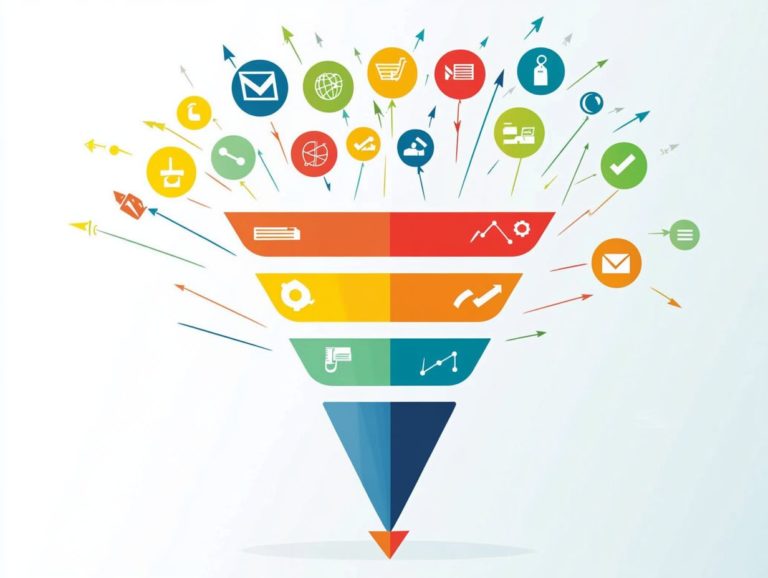10 Proven Strategies to Increase Conversion Rates
Ready to skyrocket your conversion rates? Let s dive into some exciting strategies!
Increasing your conversion rates is vital for turning casual visitors into loyal customers.
This article delves into ten proven strategies designed to elevate your website’s performance. These strategies enhance the user experience.
From optimizing loading speeds and employing high-quality visuals to implementing effective prompts that tell customers what to do next and leveraging social proof, each tactic is essential for driving conversions.
Whether you re a seasoned marketer or just starting your journey, these insights will empower you to craft a more compelling and profitable online presence.
Dive in to uncover how you can maximize your conversion potential!
Contents
- Key Takeaways:
- 1. Optimize Your Website’s Loading Speed
- 2. Use High-Quality and Relevant Visuals
- 3. Implement a Clear and Simple Call-to-Action
- 4. Utilize Social Proof and Testimonials
- 5. Offer a Seamless and User-Friendly Checkout Process
- 6. Provide Multiple Payment Options
- 7. Use Email Marketing to Nurture Leads
- 8. Make the Shopping Experience Personal
- 9. Use A/B Testing to Optimize Your Strategies
- 10. Continuously Monitor and Analyze Your Conversion Rates
- What Is a Conversion Rate and Why Is It Important?
- What Are the Common Barriers to Conversions and How Can They Be Overcome?
- How Can a Business Identify Their Target Audience for Better Conversion Rates?
- What Are the Best Practices for Creating Effective Call-to-Actions?
- How Can Social Media Help Improve Conversion Rates?
- What Are the Key Metrics to Track for Conversion Rate Optimization?
- Frequently Asked Questions
- What are conversion rates and why are they important?
- What are the top 10 proven strategies to increase conversion rates?
- How can optimizing website speed increase conversion rates?
- What is A/B testing and how can it be used to increase conversion rates?
- What is social proof and how can it impact conversion rates?
- How important is it to continuously analyze and improve website performance for conversion rates?
Key Takeaways:

- Optimize your website’s loading speed to keep potential customers engaged and reduce bounce rates.
- Utilize social proof and testimonials to build trust and credibility with your target audience.
- Constantly monitor and analyze your conversion rates to identify any potential barriers and make necessary improvements.
1. Optimize Your Website’s Loading Speed
In the competitive world of ecommerce, optimizing your website’s loading speed is essential for enhancing user experience and boosting conversion rates.
Slow-loading pages can drive users away, leading to high bounce rates and missed sales opportunities. This can significantly impact your overall business performance.
This is crucial for your site s success, especially with tools like Google PageSpeed Insights and Core Web Vitals at your disposal. These invaluable resources provide metrics that help you assess and improve your site’s performance.
By leveraging analytics, you can track your progress over time, gaining critical insights into user behaviors and understanding how page speed influences purchasing decisions.
To further enhance loading speeds, consider implementing actionable strategies such as image optimization, browser caching, and minimizing server response times. Each of these tactics not only improves site performance but also creates a smoother, more enjoyable user experience, ultimately leading to higher conversion rates.
2. Use High-Quality and Relevant Visuals
Utilizing high-quality and relevant visuals is crucial for your ecommerce store. Not only do they enhance the aesthetic appeal of your website, but they also significantly improve the customer experience, leading to higher engagement and conversion rates.
These visuals act as vital touchpoints for potential buyers. Striking images can shape perceptions of quality and trustworthiness. When you employ high-quality product photography, shoppers are more likely to feel confident in their purchasing decisions.
By using professional lighting and equipment, along with techniques like consistent backdrops and angles, you can truly elevate the professionalism of your visuals.
Equally important is maintaining a cohesive visual style across all images to strengthen your brand identity. This consistency helps customers recognize and trust your brand, ultimately fostering loyalty and encouraging repeat purchases.
3. Implement a Clear and Simple Call-to-Action
Don t wait implement clear and simple calls-to-action now to boost your results! These prompts are essential for guiding your customers towards taking meaningful commercial actions.
When crafted effectively, CTAs can significantly boost your conversion rates by harnessing customer data to create messaging that resonates deeply with your target audience.
The size and placement of these CTAs are crucial in capturing attention. Larger buttons tend to stand out more prominently, while strategic positioning such as placing them above the fold ensures they remain visible.
The wording should evoke a sense of urgency or value, prompting an immediate response from your audience. Regularly conducting A/B testing a way to see which version of a web element works better on various CTA options can reveal what truly engages consumers.
By analyzing customer interaction data, you can uncover patterns in engagement that will help you adapt your offerings and messaging, ultimately transforming casual visitors into loyal leads.
4. Utilize Social Proof and Testimonials
Use social proof like testimonials and trust badges to boost your ecommerce credibility. Positive experiences from other customers increase trust in your brand.
These elements create reliability. New visitors feel confident they are making a wise choice.
Customer reviews provide firsthand accounts of product performance and customer service. Testimonials showcase the positive transformations and satisfaction your offerings can deliver.
Incorporating third-party validation, such as trust badges from reputable organizations, further enhances this trust factor. To effectively gather this proof, actively encourage feedback through follow-up emails or incentives.
Display testimonials prominently on product pages and throughout the checkout process. Start integrating these elements today to create a trustworthy environment that builds confidence in your brand and drives higher conversion rates!
5. Offer a Seamless and User-Friendly Checkout Process
A smooth and simple checkout process is key to delighting your customers! A complicated checkout can easily lead to abandoned carts and lost sales, making it vital to optimize for both desktop and mobile users.
Consider incorporating form shortening to significantly reduce friction. By removing unnecessary fields, you encourage quicker submissions.
Clear navigation design is essential. Intuitive layouts guide users smoothly, ensuring they understand their progress without feeling overwhelmed.
Offering multiple payment options caters to diverse customer preferences, increasing the likelihood of successful transactions. When carts are abandoned, well-timed abandonment cart emails can remind potential customers of their lost items.
Personalize these emails based on user behavior and include enticing incentives, such as discounts, to draw shoppers back and complete their purchases.
6. Provide Multiple Payment Options

Providing multiple payment options in your e-commerce store is essential for accommodating the diverse preferences of your customers. By offering various methods, you enhance convenience, significantly boosting your conversion rates.
In today s fast-paced digital marketplace, understanding the distinct needs of different demographics is crucial. Customers have varying levels of comfort with payment methods.
By incorporating options like credit cards, digital wallets, and buy-now-pay-later services, you cater to these preferences and make transactions smoother.
Younger shoppers often gravitate towards digital wallets for speed and security, while others may still prefer traditional credit card transactions. This flexibility streamlines the checkout process and fosters customer loyalty.
When shoppers feel valued and understood, they are more likely to return, leading to repeat business and enhanced satisfaction. Offer multiple payment options today to create a great experience for your customers!
7. Use Email Marketing to Nurture Leads
Email marketing stands as a powerful ally in nurturing your leads and can dramatically boost your conversion rates. By leveraging customer data, you can deliver targeted content that resonates with potential buyers.
Implementing automated email series that keep your audience engaged throughout their customer journey is effective. Personalizing content based on user preferences or behaviors fosters a deeper connection, leading to increased engagement rates.
One particularly effective tactic is sending abandoned cart emails. These timely reminders encourage potential customers to complete their purchases.
To ensure your efforts yield optimal performance, track key metrics like open rates, click-through rates, and conversion rates. By analyzing these figures, refine your strategies and enhance user interaction, ultimately driving successful outcomes. Start your email campaigns today to nurture leads and boost conversions!
8. Make the Shopping Experience Personal
Making the shopping experience personal on your ecommerce site is essential for boosting customer satisfaction and increasing conversion rates. When you tailor content based on demographic data, you create a shopping environment that feels engaging and relevant.
To enhance this personalization journey, consider using tools like live chat. This approach allows you to gather real-time insights into customer preferences and behaviors, enabling you to adapt your offerings accordingly.
Understanding demographics not only helps you customize content but also fine-tunes your targeting strategies. This ensures that your promotions resonate with specific customer segments. By harnessing these tools, you can transform the ecommerce experience into one that speaks directly to each individual, ultimately fostering loyalty and encouraging repeat visits.
9. Use A/B Testing to Optimize Your Strategies
Using A/B testing gives you the power to systematically optimize your ecommerce content and strategies by comparing different versions to see which one performs better. This approach enables you to make informed, data-driven decisions for continuous improvement.
The process begins with identifying key elements that can significantly influence user engagement and conversion, such as headlines, images, call-to-action buttons, and overall layout. Once you ve pinpointed potential variables, the next step is to set up controlled experiments, presenting two or more versions to different segments of your audience.
By using analytics tools, you can monitor user interactions and measure success through essential metrics like click-through rates and sales conversions. For instance, testing various headlines may uncover which resonates more effectively with your customers. This allows you to refine your marketing messages and enhance your performance.
10. Continuously Monitor and Analyze Your Conversion Rates
Continuously monitoring and analyzing your conversion rates is crucial for your ecommerce business. This practice gives you valuable insights into customer behaviors and the effectiveness of your marketing strategies. This enables you to make timely adjustments that optimize performance.
Using tools like Google Analytics can supercharge your insights. By setting up conversion tracking, you gain access to essential metrics such as conversion funnels, bounce rates, and average session duration. Interpreting this data helps you identify trends over time, revealing which marketing campaigns resonate best with your audience.
Examining demographics and user behavior can inform your strategic decisions, leading to targeted approaches that enhance customer engagement.
Ultimately, leveraging these insights sets the stage for improving your overall business performance and adapting to the ever-evolving market landscape.
What Is a Conversion Rate and Why Is It Important?
A conversion rate is a crucial performance indicator that reveals the percentage of visitors to your ecommerce website who take desired actions, like making a purchase or signing up for a newsletter. Understanding its significance is essential for optimizing your digital contact strategies and achieving overall business success.
This metric acts as a vital gauge of how effectively your site engages users, transforming casual browsers into committed customers. By closely monitoring conversion rates, you can identify specific areas that need improvement, such as user interface design, clarity of product descriptions, or your promotional strategies.
Using analytics tools allows you to conduct a detailed examination of visitor behavior, helping you pinpoint obstacles that might be hindering the purchasing process. Adapt your marketing strategies with these insights to enhance user experiences, boost sales, and ultimately achieve sustained growth in a competitive market.
What Are the Common Barriers to Conversions and How Can They Be Overcome?

Common barriers to conversions can significantly hinder your ecommerce success. Complicated checkout processes, limited payment options, and inadequate customer support are just a few obstacles. Understanding these challenges allows you to implement effective strategies, like abandoned cart emails, to overcome them.
Consider the impact of poor website navigation. It frustrates users and leads to higher bounce rates. A well-structured menu and intuitive layout create a seamless browsing experience, making it easier for customers to find what they want.
Unclear calls to action (CTAs) can confuse visitors. It s crucial to craft compelling, concise CTAs that clearly guide users toward their desired actions. Enhancing content quality and integrating live chat support can offer instant help, ensuring that questions or concerns are addressed promptly. This builds trust and encourages conversions, turning casual visitors into loyal customers.
How Can a Business Identify Their Target Audience for Better Conversion Rates?
Identifying your target audience is essential for boosting conversion rates. When you understand who your customers are and what they like, you can tailor your marketing strategies effectively.
Consider various methods to gather customer data. Surveys provide valuable insights into what customers like, while web analytics help track user interactions.
Carefully analyzing the information allows you to identify distinct segments within your audience. This segmentation helps personalize your marketing efforts, enhancing engagement by delivering content that resonates with specific groups. Ultimately, this drives leads and fosters brand loyalty, setting you up for success.
What Are the Best Practices for Creating Effective Call-to-Actions?
Creating effective calls-to-action (CTAs) is crucial for driving conversions. Focus on clear wording, strategic placement, and use A/B testing to find which CTAs work best.
Use action-oriented language that inspires immediate responses, like “Get Started Now” or “Join Free Today.” The visual design of your buttons also plays a significant role; vibrant colors and appropriate sizing effectively capture attention and encourage clicks.
Understanding where to place CTAs throughout the user journey allows for strategic positioning that maximizes visibility. Regularly engaging in A/B testing provides insights by comparing different versions. This helps refine both your messages and designs, ultimately leading to improved conversion rates and a better user experience.
How Can Social Media Help Improve Conversion Rates?
Social media is crucial for boosting conversion rates in your eCommerce business. It enhances customer engagement, builds brand awareness, and creates a way for direct communication with potential buyers.
Utilize targeted ads to reach specific demographics and craft messages that resonate with your audience, maximizing conversion chances. Partnering with influencers can provide genuine endorsements that elevate your brand’s visibility and trustworthiness.
Creating engaging, visually captivating content captures attention and nurtures a community around your brand, encouraging user-generated content and sharing. As customers engage with your brand on these platforms, their experience is enriched, fostering loyalty and driving traffic to your online store.
Use social media wisely to thrive in the competitive digital marketplace! Don’t miss out! Start connecting with your audience today!
What Are the Key Metrics to Track for Conversion Rate Optimization?
Monitoring key metrics is crucial! It unveils the secrets to enhancing your conversion rates.
Tracking key metrics is essential for improving the rate at which visitors take desired actions on your site in your e-commerce business.
These metrics provide valuable insights into customer behavior and the performance of your marketing strategies.
By closely monitoring critical metrics like conversion rate, bounce rate, and average order value, you can gain a clearer understanding of what drives customer engagement and purchasing decisions.
Analytics plays a pivotal role in interpreting these metrics, enabling you to make informed adjustments to your marketing tactics and website design.
For example, an elevated bounce rate might signal problems with your landing page content. A low average order value could hint at opportunities to improve product bundling or enhance your upselling strategies. Ultimately, leveraging this data helps you refine your overall approach, making the customer journey smoother and more tailored to their needs.
Frequently Asked Questions
What are conversion rates and why are they important?

Conversion rates refer to the percentage of website visitors who take a desired action, such as making a purchase or filling out a form. They are important because they directly impact the success and profitability of a business.
What are the top 10 proven strategies to increase conversion rates?
- Optimize your website for speed and easy navigation.
- Use clear and compelling calls-to-action.
- Implement A/B testing to determine the most effective design and messaging.
- Personalize the user experience.
- Utilize social proof and customer reviews.
- Offer discounts or promotions.
- Simplify the checkout process.
- Use persuasive and informative product descriptions.
- Utilize email marketing to nurture leads.
- Continuously analyze and improve your website’s performance.
How can optimizing website speed increase conversion rates?
Research shows that a one-second delay in page load time can cause a 7% decrease in conversions. By optimizing your website for speed, you can reduce the chances of potential customers getting frustrated and leaving before completing a desired action.
What is A/B testing and how can it be used to increase conversion rates?
A/B testing involves creating two versions of a webpage or element and testing them against each other to see which one performs better. By using this method, businesses can determine the most effective design and messaging to increase conversions.
Social proof refers to the influence that the actions and opinions of others have on our own behavior. By showcasing customer reviews, testimonials, and social media followers, businesses can build trust and credibility with potential customers, ultimately increasing conversion rates.
How important is it to continuously analyze and improve website performance for conversion rates?
It is crucial to regularly analyze and improve website performance to increase conversion rates. Consumer behavior and preferences are constantly evolving, so businesses must adapt and make changes to keep up with their target audience’s needs and expectations.






